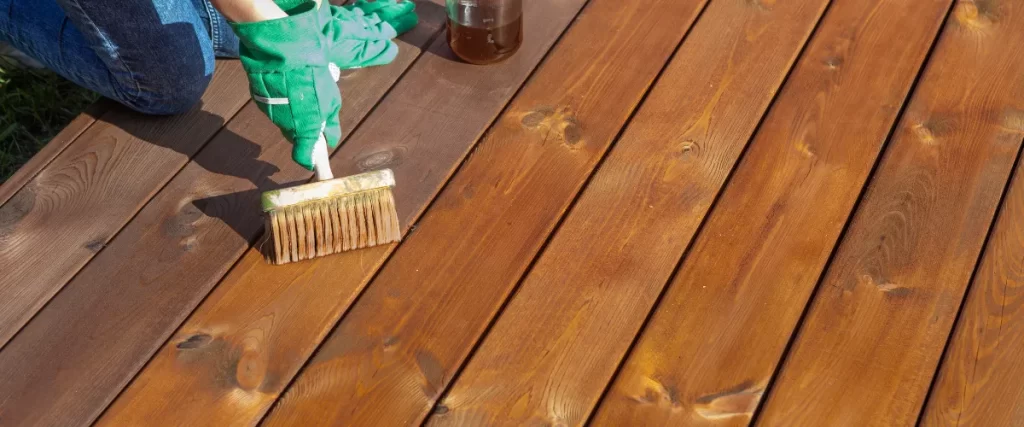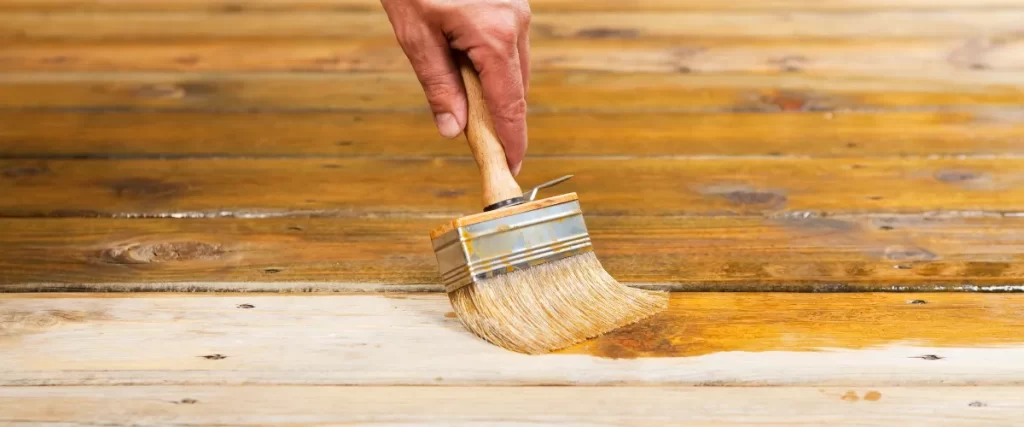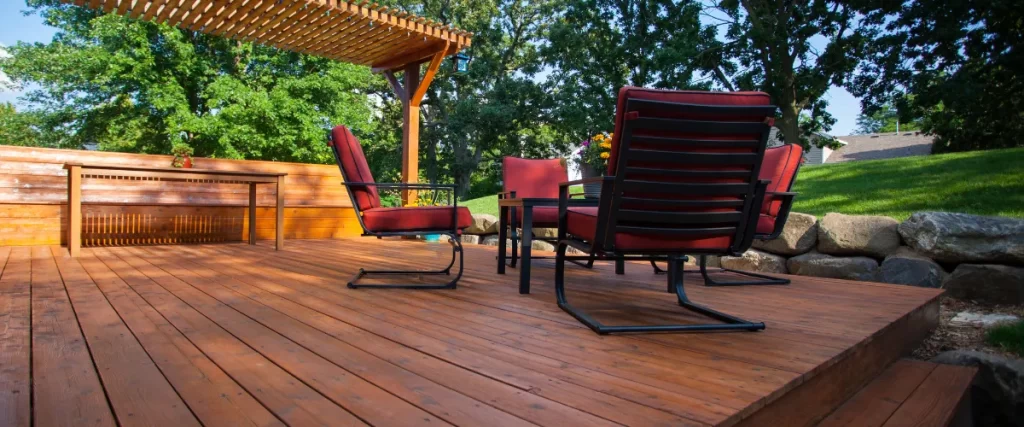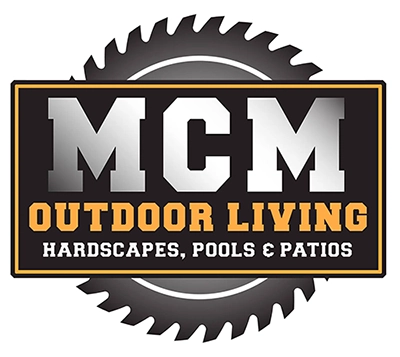If your deck is looking weathered and tired, the right sealer can do more than just improve its appearance. It can protect against further damage, extend its life, and make maintenance easier in the long run.
Based on years of deck restoration experience, semi-transparent and semi-solid penetrating stains remain the most effective choice for old decks. They soak deep into the wood, resist peeling, and enhance the surface without creating a brittle film.
Quick Answer: For most old decks, Restore-A-Deck (water-based, great for fast same-day prep and stain) and TWP 100 or 1500 Series (oil-based, deep penetration and high durability) stand out for long-term protection. If your deck is badly dried out, Armstrong-Clark oil-based stains replenish the wood with conditioning oils.
Why Old Decks Need the Right Sealer
Older decks face more than just cosmetic issues. Years of sun, rain, and temperature swings weaken the fibers, making them more prone to cracking, splitting, and rot. The wrong coating can peel or trap moisture, speeding up deterioration.
A high-quality penetrating sealer solves three key problems:
- Moisture protection: Stops water absorption that causes swelling and warping.
- UV defense: Prevents fading, graying, and surface breakdown.
- Longevity: Slows down wear so you don’t have to repeat the work as often.
1. Restore-A-Deck (Water-Based Semi-Transparent)
Designed for older wood, it penetrates deeply, resists mildew, and provides solid UV protection. The standout feature is its ability to be applied to damp wood, so cleaning and staining can be done on the same day.
Restore-A-Deck is praised for its easy maintenance cycle. When it’s time to recoat, a simple wash is often enough to prepare the surface. This makes Restore-A-Deck a practical choice for homeowners who value speed and efficiency without giving up durability.
Best for: Homeowners wanting quick turnaround without sacrificing performance.
2. TWP 100 & 1500 Series (Oil-Based Semi-Transparent)
Both series are known for deep penetration, UV resistance, and ease of maintenance. The 100 Pro Series works well in sunny conditions and fades evenly, while the 1500 Series offers low-VOC compliance in all states.
TWP products excel in color retention. The pigments hold their tone longer than many competing brands, which helps keep decks looking fresh between applications. This is why TWP is often recommended for high-visibility outdoor spaces where appearance matters as much as protection.
Best for: Decks exposed to full sun or harsh climates where durability is critical.
3. Armstrong-Clark (Oil-Based Semi-Transparent)
Packed with conditioning oils, this stain restores flexibility to dry, brittle wood. It applies smoothly and penetrates well, making it reliable for severely weathered decks.
Armstrong-Clark is known for staying flexible within the wood rather than becoming brittle on the surface. This flexibility helps it resist cracking or peeling over time, even in changing weather conditions. It’s a solid option for decks that have been neglected and need more than just a cosmetic fix.
Best for: Older decks that have dried out and need rejuvenation.

Choosing Between Sealers, Stains, and Paints
When restoring an old deck, the coating you choose will affect how it looks now and how well it holds up over the next few years. Each option has its place, but the wrong one can lead to more work than necessary.
Deck Sealers
Usually clear or lightly tinted, sealers protect the wood from water penetration while keeping its natural appearance. Most sealers have limited UV protection, so the wood may still turn gray over time. Expect to reapply every year or so.
Sealers are best for decks that are already in good condition and for homeowners who are willing to maintain them regularly.
Deck Stains
Stains change the wood’s color while sealing it against moisture. They are available in different opacities that control how much grain shows and how much UV protection you get.
For most old decks, a semi-transparent or semi-solid penetrating stain works best because it offers good protection, improves the look, and is easier to maintain than a surface coating.
Solid Stains and Deck Paints
These create a uniform, opaque finish that hides imperfections and discoloration. They are a good choice for heavily weathered decks where the wood grain is no longer attractive.
The trade-off is maintenance. Over time, these finishes can crack or peel, and reapplication often requires scraping, sanding, and a complete new coat.
Opacity Levels and Their Role
The opacity of a stain controls how much of the wood grain you will see and how much UV protection the product provides. Deciding on the right opacity is one of the first steps in choosing a deck finish, especially for older decks where appearance and protection both matter.
- Transparent: Shows the full wood grain with the least UV protection. Best for decks in excellent condition but requires the most frequent maintenance.
- Semi-Transparent: Shows much of the grain while adding color and good UV defense. Often the easiest option to maintain over time.
- Semi-Solid: Adds more color coverage but still allows some grain to show. Offers more protection than semi-transparent while softening imperfections.
- Solid/Opaque: Covers the grain entirely, hiding flaws and creating a uniform look. Offers maximum coverage and UV protection but is harder to maintain due to potential peeling.
After deciding how much grain you want to show and the level of protection you prefer, the next step is to choose between oil-based and water-based products to achieve those results.

Oil-Based vs Water-Based Sealers
Oil-based and water-based sealers both protect wood, but they work in different ways. Each has its own strengths and trade-offs.
Oil-Based:
- Deeper penetration into aged wood
- Better suited for rough or imperfect surfaces
- Longer-lasting between applications (often 3–5 years)
- Requires solvent cleanup and emits stronger fumes
Water-Based:
- Easier to clean up (soap and water)
- Low-VOC options available
- Can be applied to slightly damp wood
- Faster drying times but shorter lifespan (2–3 years typical)
Application Tips for Old Decks
The way you apply a sealer or stain can make as much difference as the product itself. Good preparation and proper technique will help the finish last longer and look better.
Thorough Cleaning: Use a quality deck cleaner and brightener. Remove all dirt, mildew, and any remaining old coating. This helps the new product bond properly.
Drying Time: Some products allow application to damp wood. Even so, always follow the manufacturer’s moisture guidelines to avoid adhesion problems.
Even Application: Work in small sections. Use a brush or stain pad to keep coverage consistent and avoid lap marks.
Number of Coats: Most penetrating stains perform best with two light coats. Avoid heavy application, which can cause uneven drying or sticky spots.
Timing Maintenance: Inspect your deck each year. If water no longer beads on the surface or the color looks faded, it’s time for another coat.
Mistakes to Avoid
- Using a film-forming product on old wood, which can trap moisture and peel
- Skipping the cleaning step before sealing
- Applying stain in direct midday sun, causing uneven absorption
- Ignoring VOC restrictions when buying oil-based products

Bringing New Life to an Old Deck
The best sealer for an old deck is one that penetrates the wood and works with its condition. It should protect the surface while enhancing its appearance.
Semi-transparent and semi-solid penetrating stains are often the best fit. Brands like Restore-A-Deck, TWP, and Armstrong-Clark have a proven track record for durability, UV protection, and ease of upkeep.
With the right preparation and a quality product, your deck can remain a strong and inviting part of your outdoor space for many more years.
Ready to Restore Your Deck?
If your old deck needs more than a DIY touch, our professional deck staining service can bring it back to life. We use proven products and techniques to protect your wood, enhance its appearance, and make it last for years.
Contact us today at (469) 583-6213 to schedule your free consultation. We can also assess if your deck would benefit from a full rebuild, so you get the solution that fits your home and budget.
